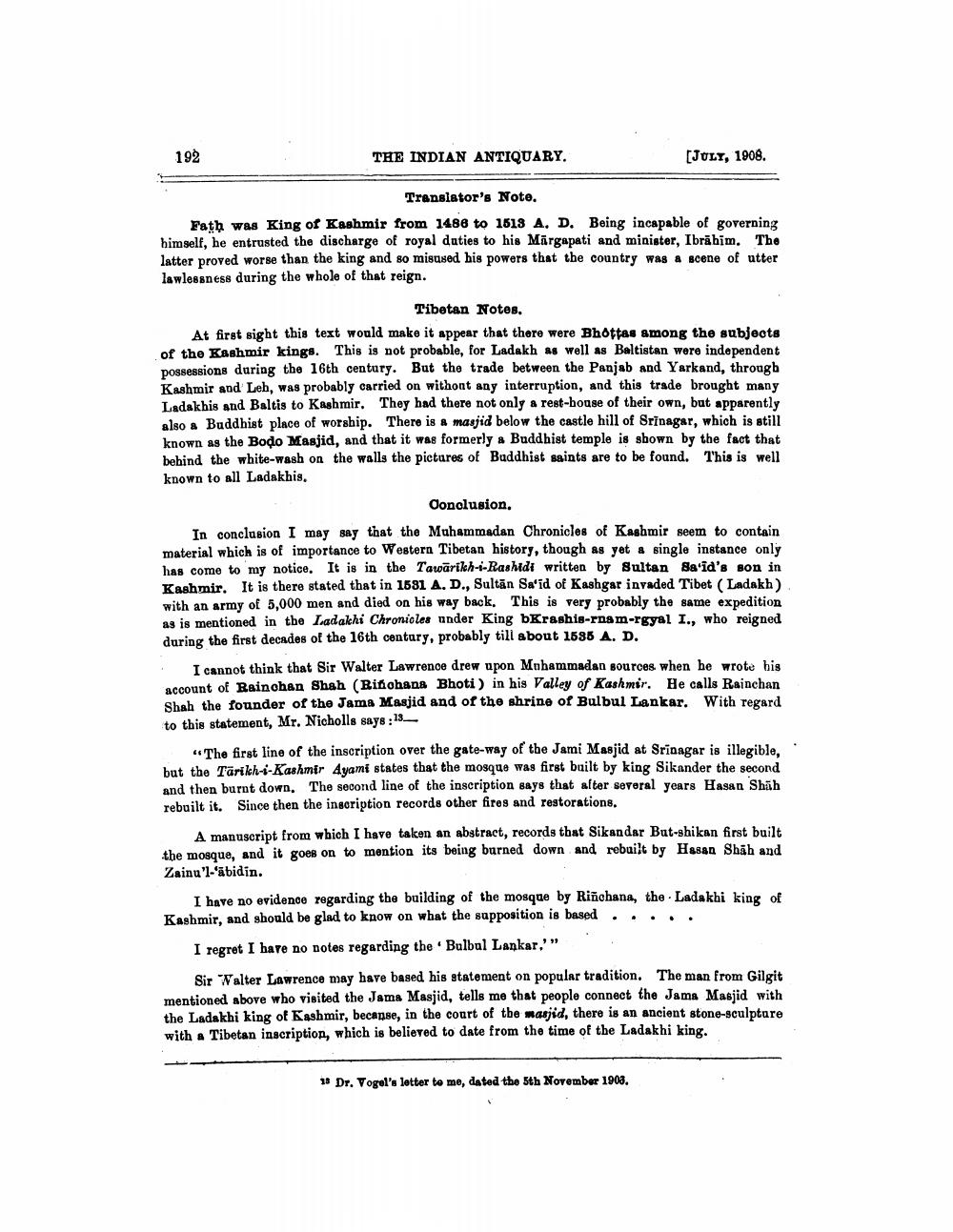________________
192
THE INDIAN ANTIQUARY.
[JULY, 1908.
Translator's Note. Fath was King of Kashmir from 1486 to 1513 A, D. Being incapable of governing himself, he entrusted the discharge of royal duties to his Märgapati and minister, Ibrāhīm. The latter proved worse than the king and so misused his powers that the country was a scene of utter lawlessness during the whole of that reign.
Tibetan Notes. At first sight this text would make it appear that there were Bhottas among the subjects of the Kashmir kings. This is not probable, for Ladakh as well as Baltistan were independent possessions during the 16th century. But the trade between the Panjab and Yarkand, through Kashmir and Leh, was probably carried on without any interruption, and this trade brought many Ladakhis and Baltis to Kashmir. They had there not only a rest-house of their own, but apparently also a Buddhist place of worship. There is a masjid below the castle hill of Srinagar, which is still known as the Bodo Masjid, and that it was formerly a Buddhist temple is shown by the fact that behind the white-wash on the walls the pictures of Buddhist saints are to be found. This is well known to all Ladakhis.
Conclusion. In conclusion I may say that the Muhammadan Chronicles of Kashmir seem to contain material which is of importance to Western Tibetan history, though as yet a single instance only has come to my notice. It is in the Tawārikh--Rashidi written by Sultan Sa'id's son in Kashmir. It is there stated that in 1581 A. D., Sultān Sa'id of Kashgar invaded Tibet (Ladakh) with an army of 5,000 men and died on his way back. This is very probably the same expedition ng is mentioned in the Ladakhi Chronicles under King bKrashis-nam-rgyal I., who reigned during the first decades of the 16th century, probably till about 1595 A. D.
I cannot think that Sir Walter Lawrence drew upon Mohammadan sources when he wrote his account of Rainohan Shah (Binohana Bhoti) in his Valley of Kashmir. He calls Rainchan Shah the founder of the Jama Masjid and of the shrine of Bulbul Lankar. With regard to this statement, Mr. Nicholls says : 13
"The first line of the inscription over the gate-way of the Jami Masjid at Srinagar is illegible. but the Tarikh-i-Kashmir Ayami states that the mosque was first built by king Sikander the second and then burnt down. The second line of the inscription says that after several years Hasan Shūh rebuilt it. Since then the insoription records other fires and restorations.
A manuscript from which I have taken an abstract, records that Sikandar But-shikan first built the mosque, and it goes on to mention its being burned down and rebuilt by Hasan Shah and Zainu'l-'abidin.
I have no evidence regarding the building of the mosque by Riñchana, the Ladakhi king of Kashmir, and should be glad to know on what the sapposition is based .. ...
I regret I have no notes regarding the Bulbul Lankar.'"
Sir Walter Lawrence may have based his statement on popular tradition. The man from Gilgit mentioned above who visited the Jama Masjid, tells me that people connect the Jama Masjid with the Ladakhi king of Kashmir, because, in the court of the masjid, there is an ancient stone-sculpture with a Tibetan inscription, which is believed to date from the time of the Ladakhi king.
13 Dr. Vogel's letter to me, dated the sth November 1908.




